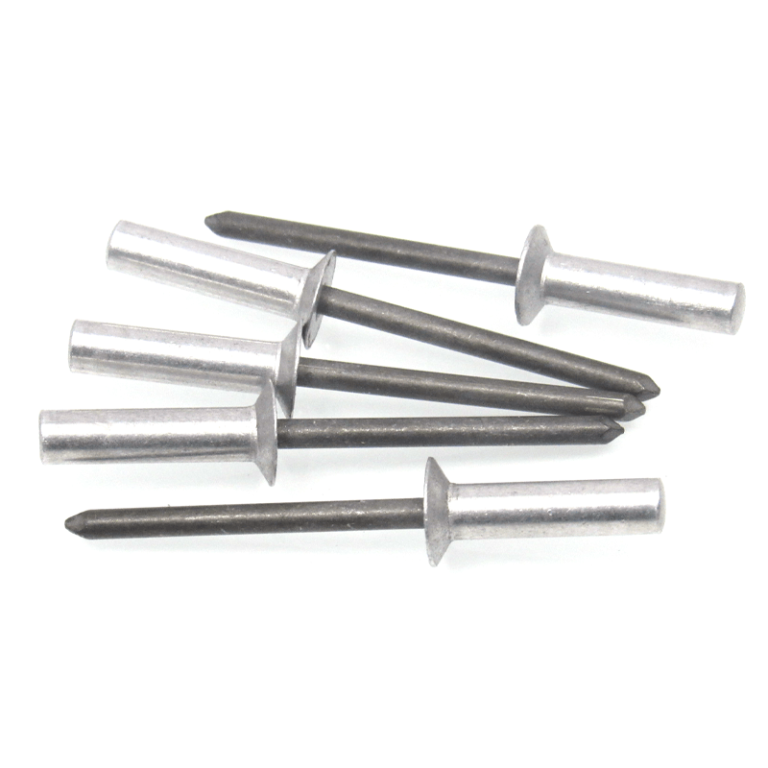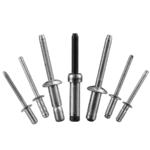Table of Contents

Closed end rivets are commonly used as blind rivets in industrial manufacturing processes, and I’m sure you’ve come across and purchased closed end rivets in your business, so have you had an in-depth look at what is a closed end rivet?
Next, I will explain the following closed end rivet in detail for you.
Table of Contents
What is a Closed End Rivet?

Closed end rivets are a type of blind rivet. Unlike ordinary rivets, closed end rivets are watertight. closed end rivets form a seal at the end of the rivet after installation, effectively preventing liquids or gases from leaking through the riveted joint.
Closed end blind rivets are available in dome head, countersunk head and large flange head. And it can provide 100% mandrel fixing, this feature makes it widely used in electronic equipment or other electrical applications.
Types of Closed End Rivets
Closed end rivets come in many different types, but what they all have in common is that they are waterproof.
So what are the different types of closed end rivets?
Different Materials
Closed end rivets are made from different materials to suit different purposes. Here are some common material combinations for closed end rivetd.
- Carbon Steel Mandrel / Aluminum Body
- Aluminum Mandrel / Aluminum Body
- Stainless Steel Mandrel / Aluminum Body
- Carbon Steel Mandrel / Carbon Steel Body
- 420 Stainless Steel Mandrel / 304 Stainless Steel Body
- 304 Stainless Steel Mandrel / 304 Stainless Steel Body
- 316 Stainless Steel Mandrel / 316 Stainless Steel Body
- Carbon Steel Mandrel / Copper Body
Some materials cannot be used together. For example, aluminum and copper can corrode electrochemically. If you have a need for closed end rivets, you can contact us to get these high quality closed end rivets.
Different Head Shapes


Rivmate can provide you with closed end rivets for all common head sizes on the market.
- Dome Head Closed End Rivets
- Countersunk Head Closed End Rivets
- Large Flange Head Closed End Rivets
What is the Difference Between Open And Closed End Rivets?
Closed end rivets and open end rivets belong to the two types of blind rivets that are commonly used. They differ significantly in design, function and application scenarios.
Design and Structure
Open End Rivet has an open end. During the riveting process, the mandrel pulls the rivet body to deform the end to form a “ball” shaped locking structure.
Closed End Rivet tail is closed, forming a sealed cavity, in the riveting process, the tail deformation remains sealed.
Functionality and Performance
Open end rivets do not provide a seal and are not suitable for applications where water or gas resistance is required. It provides good mechanical joint strength for general structural and assembly tasks, but does not perform as well as closed end rivets in highly corrosive environments.
Closed end rivets provide an effective seal against leakage of liquids and gases through the riveted joint and are well suited to applications where a seal is required. And its closed design provides additional corrosion protection for more demanding environmental conditions.
Applications

Open end rivets are widely used in a variety of industrial and manufacturing applications such as sheet metal working, furniture manufacturing, household appliances and light structural assembly.
Open end rivets are suitable for high volume production and cost sensitive projects due to their low manufacturing cost and ease of installation.

Closed end rivets are suitable for scenarios requiring hermetic sealing, such as the automotive industry, electronic equipment, construction and infrastructure, marine and shipbuilding, aerospace and more. And due to their waterproof and corrosion-resistant properties, closed end rivets excel in high humidity and corrosive environments, ensuring long-term reliability of the connection.
The above briefly explains the different application scenarios of open end rivets and closed end rivets. If you want to know more about the different applications of blind rivets, please read the following article “Applications of blind rivets“.
| Feature | Open-End Rivet | Closed-End Rivet |
| Tail Design | Open | Closed |
| Sealing Capability | No sealing function | Provides sealing, preventing liquid and gas leakage |
| Strength and Suitability | Suitable for general structural and assembly tasks | Suitable for applications requiring sealing and in highly corrosive environments |
| Corrosion Resistance | Lower, especially in corrosive environments | Higher, suitable for humid and corrosive environments |
| Application Scenarios | Sheet metal work, furniture manufacturing, home appliances, light structural assembly | Automotive industry, electronic devices, construction and infrastructure, marine and shipbuilding, aerospace |
| Ease of Installation | Easy to install, suitable for mass production and cost-sensitive projects | Similar installation process but requires specialized tools to ensure sealing |
| Typical Uses | General industrial applications | Applications requiring water or airtight sealing and corrosion resistance |
I made a brief explanation of open end rivets and closed end rivets. And it’s listed in a tabular comparison. If you want a deeper understanding of “open end vs closed end rivets”, read this hyperlinked article.
Are Closed End Rivets Watertight?
Closed end rivets were designed from the ground up to be waterproof. Its design features make it particularly suitable for applications where sealing is required.
So why are closed end rivets waterproof?
The waterproof performance of closed end rivets depends on the following two aspects:
- Closed end design
- Materials and Coatings

1. Closed End Sign
Closed end rivets have a closed end, forming a complete sealing chamber. This design prevents leakage of liquids or gases through the rivet joint during rivet installation, ensuring a watertight connection.
2. Materials and Coatings
Corrosion-Resistant Materials: Sealed rivets are typically made of stainless steel, aluminum or other corrosion-resistant materials that are inherently waterproof and corrosion-resistant.
Protective Coatings: Protective coatings are added to the surface of some Sealed Rivets to further enhance their water and corrosion resistance.
In addition to the closed end rivet, there are other types of rivets in the blind rivet that are also waterproof. If you want to know more about waterproof rivets, please read my article “are rivets waterproof?”. This article explains in detail whether rivets are waterproof or not.
Conclusion
Having read this far, I believe you have a brief understanding of “what is a closed end rivet”. Whether it’s types of closed end rivets or closed end blind rivets, you’ve gained a deeper understanding of the material and head shape through this article.
Engineers often use closed end rivets in devices that need to be waterproof and dustproof. This reduces the overall cost of the project and ensures that the equipment operates properly.
If you are looking for a reliable manufacturer of closed end pop rivets. Contact us today. You will find a satisfactory answer!
Rivmate Has the Closed End Rivets You Need
Rivmate has closed end rivets for every application.We offer closed end rivets in a variety of diameters, lengths, and materials, so you can find the closed end rivets you need no matter what your project is.
If you are not sure which closed end rivets are practical for your project. Please contact one of our specialized engineers. They will give you a suitable suggestion and solution for closed end rivets.
Of course, Rivmate provides more than just various types of closed end rivets. If you have other blind rivets sourcing needs, you can contact us!



